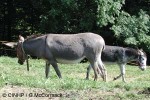Cook Islands Biodiversity Database
Species Page
EXTINCTEquus asinus
‘ĀtiniDonkey
Multimedia & Additional Resources
| Type | Description | Download |
| Donkey and foal (Switzerland) | 79KB |
General Information
Cook Islands Distribution
| Southern Group: X Makatea: | ||||||||
RR |
MG |
AT |
MK |
MT |
AK |
PL |
TK |
MN |
X |
- |
- |
- |
- |
- |
- |
||
| Northern Group: - | |||||
TN |
MH |
RK |
PK |
NS |
SW |
- |
- |
- |
- |
- |
- |
Scientific Taxonomy
Equus asinus L.
TAXONOMY: ANIMALIA; CHORDATA; GNATHOSTOMATA (Jawed Vertebrates); TETRAPODA; MAMMALIA; THERIA; EUTHERIA; Perissodactyla; EQUIDAE
More Information
GENERAL NOTE: Domesticated about 4.500 years ago in Northern Africa, Middle East and Europe. Their small size made them ideal for riding on winding hilly tracks. Ass is the more correct name, although they are commonly called donkey from the Old English dunkey meaning a greyish-brown animal. Asses and horses can produce offspring although they are sterile. The offspring are often called Mules, although this name more correctly refers to the offspring of a Jack (male ass) with a Mare. A sterile male offspring is a John or Horse Mule, while a sterile female is a Molly or a Mare Mule. The offspring of a Stallion (male horse) with a Jennet is a Hinney.
Vouchers & References
Vouchers:
None Recorded.
References:
None recorded.
Data Update History (information):
zTX, zB02, zM02, zD02
Web Resources
Citation Information
McCormack, Gerald (2007) Cook Islands Biodiversity Database, Version 2007.2. Cook Islands Natural Heritage Trust, Rarotonga. Online at http://cookislands.bishopmuseum.org. ![]()
Please refer to our use policy.

